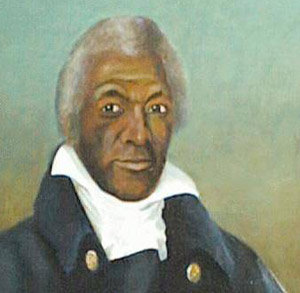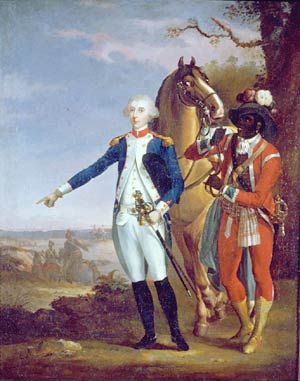
James Armistead
 James Armistead Lafayette was the first African American double spy. An African
American slave, Armistead was owned by William Armistead in Virginia during the
American Revolution. James Armistead took the surname of Lafayette to honor
General Lafayette, whom he served under in the Revolutionary War.
James Armistead Lafayette was the first African American double spy. An African
American slave, Armistead was owned by William Armistead in Virginia during the
American Revolution. James Armistead took the surname of Lafayette to honor
General Lafayette, whom he served under in the Revolutionary War.
Because Slave-owners seldom kept records of the births of the
people they enslaved, it is unclear exactly when and where James Armistead was
born, but most records agree that he was born in 1748 in Elizabeth City,
Virginia.
James Armistead volunteered to join the army in 1781. After gaining the
consent of his owner, Armistead was stationed to serve under the Marquis de
Lafayette, the commander of French forces allied with the American Continental
Army. Lafayette employed Armistead as a spy. While working for Lafayette he
successfully infiltrated British General Charles Cornwallis's headquarters
posing as a runaway slave hired by the British to spy on the Americans.
Armistead got work in a British camp as a forager, a person who gathers food from the countryside. His job allowed him to move freely between the British and American camps. The British grew to trust him so much that they asked him to spy on the Americans! As a double agent, Armistead gave useful information to Lafayette while giving false information to the British.
In the summer of 1781, General George Washington sent a message to General Lafayette, instructing him to keep his forces strong and to inform him of Cornwallis's equipment, military personnel, and future strategies. Lafayette sent several spies to infiltrate Cornwallis's camp, yet none proved able to produce valuable information until James Armistead. His activities contributed to the British defeat at Yorktown.
After the Revolution, Lafayette praised Armistead for his dedication and instrumental role in the surrender at Yorktown. Armistead returned to William Armistead after the war to continue his life as a slave, as he was not eligible for emancipation under the Act of 1783 for slave-soldiers since he was considered a slave-spy. In 1784, Lafayette found Armistead in Virginia and disappointed to find he was still a slave, wrote a testimonial on Armistead's behalf and two years later the Virginia General Assembly emancipated him. It was at this time that Armistead made "Lafayette" his last name, in honor of the General.
Some black Americans with the last name of Armistead are suspected of being descendants of James Armistead Lafayette as he is said to have had a number of children after the Revolution. Also it is possible that James was an illegitimate son of William Armistead, The Purser of the Virginia Troops. Regardless of his birth, he is remembered as an American patriot. His intelligence contributions to Lafayette and Washington aided in the capture General Cornwallis at Yorktown, Virginia with few shots fired.
The sad commentary of the indignities of being a slave cannot be ignore in James Armistead story. Wanting to fight for a country that had enslaved him, yet still needing permission from his owner shows the total lack of understanding that a man, regardless of the color of his skin was due the very rights that we were fighting for in the Revolutionary War. Although James Armistead could have escaped to freedom, or double crossed those who had enslaved him, he chose instead to be of high moral character and a man of his word. He fought bravely for a country that was not willing to allow him the basic right of freedom, and in the end was relegated back into slavery until General Lafayette interceded several years later.
Although the story of James Armistead is told as a hero's story and indeed James was a hero, it was really a commentary on prevailing attitude toward racism.
 Like
the portrait of Lafayette in which James Armistead appears (shown here), blacks
are frequently present in surviving documents but almost always as objects of
concern rather than as self-reflecting subjects. Portraits like Paon's do not
make blacks more visible as subjects. But they do illustrate for us a pattern of
representation that is so ubiquitous in surviving written documents that it is
easy to overlook. On its own, such an image merely suggests yet another example
of slave-owning conceit or planter-class self-indulgence. However, when overlaid
on the written record, portraits like Paon's re-enact for us a critical feature
of enslavement.
Like
the portrait of Lafayette in which James Armistead appears (shown here), blacks
are frequently present in surviving documents but almost always as objects of
concern rather than as self-reflecting subjects. Portraits like Paon's do not
make blacks more visible as subjects. But they do illustrate for us a pattern of
representation that is so ubiquitous in surviving written documents that it is
easy to overlook. On its own, such an image merely suggests yet another example
of slave-owning conceit or planter-class self-indulgence. However, when overlaid
on the written record, portraits like Paon's re-enact for us a critical feature
of enslavement.
In order to survive in early America blacks had to accept the self-denying
identity, Negro. Those who refused to do so did not survive. It was that simple
and that terrifying. The process was often a brutal one, driven by physical
violence and torture. Brutality was a means to an end, however, not the
preferred way of achieving it. Slavery as an institution, representing the
economic foundation upon which much of colonial antebellum America was grounded,
could not be run as a prison camp, not day in, day out for more than two and a
half centuries. Instead, physical violence was used to create a climate of
terror in which the necessity of becoming a Negro, or at least convincingly
pretending to do so, became a part of the slaves' intuitive understanding of
what it meant to survive, a, a self-perpetuating means of self-enslavement.
The way blacks were visually portrayed, and the ways in which they were forced to project in daily life the same lack of subjectivity that comes through in these rare portraits, demonstrate this unrelenting assault on the slave's sense of self. Unintentionally, portrait painters like Paon provided us with a glimpse of that process as it was experienced by a few survivors. The fact that Armistead, through his own initiative, was a privileged survivor only heightens the effect.
Major General Charles F. Bolden, Jr. Corporal Buddie Branch Vice Admiral David L. Brewer III Rear Admiral Erroll M. Brown
Staff Sergeant Edward A. Carter, Jr. Brigadier General Roscoe C. Cartwright Rear Admiral Osie V. Combs
Four Star General Benjamin Davis Major General Arnold Fields Rear Admiral Lillian Fishburne First Lieutenant John R. Fox
Vice Admiral Samuel Gravely, Jr. Major General James F. Hamlet Harlem Hellfighters 4 Star General Daniel James Jr.
Private First Class Willy F. James, Jr. Corporal Harry Johns Major Robert H. Lawrence, Jr.
Staff Sergeant Aubrey L. McDade, Jr. Vice-Admiral Ed Moore Four Star General Lloyd W. Newton
Captain Joseph N. Peterson General Colin Powell Captain Ronald A. Radcliffe Admiral J. Paul Reason
Four Star General Edward A. Rice Jr. Staff Sergeant Ruben Rivers Clifford Chester Sims Robert Smalls
Major General Clifford L. Stanley Tuskegee Airmen Lieutenant Colonel Merryl (David) Tengesdal
Captain Charles L. Thomas Private George Watson Major General Leo V. Williams, III Colonel Charles Young
Alaskan Nature | |Floridian Nature | Free Holiday Ideas | Reflections | Michael Arnold Art
|